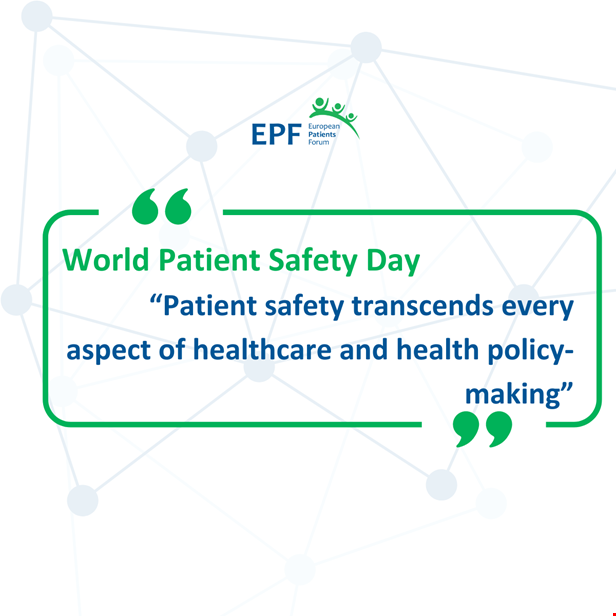World Patient Safety Day

Like every year, Patient Safety Day on 17 September reminds us of the key objective of the 2019 Resolution “Global action on patient safety” adopted by the 72nd World Health Assembly: to ensure patient safety is recognised “as a health priority in health sector policies and programmes”. This Resolution led to the adoption of the Global Patient Safety Action Plan 2021–2030 which outlines concrete steps to eliminate avoidable harm in healthcare and improve patient safety in different practice domains.
This year, the World Health Organization (WHO) chose “Improving diagnosis for patient safety: Get it right, make it safe!” as the theme for Patient Safety Day. Accurate and timely diagnosis is critical for patients. It provides the basis for many healthcare decisions and determines patients’ access to the care they need. Early diagnosis can significantly improve health outcomes, while innovative diagnosis tools can support more personalised prevention and treatment strategies. However, diagnostic errors account for nearly 16% of preventable harm across health systems, including “delayed, incorrect, or missed diagnoses, or a failure to communicate that explanation to the patient”. More importantly, diagnostic errors reflect broader challenges within healthcare systems that require structural solutions:
- Lack of healthcare systems’ resilience: The COVID-19 pandemic exposed the weakness of healthcare systems and led to significant delays in accessing diagnosis and care for chronic diseases patients. The pandemic also exacerbated the healthcare workforce crisis, with an estimated shortage of 1 to 2 million health workers. Healthcare professionals’ stress, fatigue, and lack of time increase the risks of diagnostic and medical errors as well as adverse events, negatively affecting patient safety and trust in healthcare systems.
- Healthcare inequalities: Access to timely and accurate diagnosis reflects broader inequalities in healthcare access, which still varies based on patients’ location, nationality, socio-economic status, etc. Diagnostic errors also result from biases, where patients are treated differently based on how they look or who they are. Improving patient safety goes hand in hand with realising the promise of universal access to healthcare for all, without discrimination.
- Lack of patient-centred healthcare systems: To improve patient safety, healthcare systems must be centered around patients’ needs, goals, and preferences. This includes clear communication and shared decision-making between patients and healthcare professionals. Investing in health literacy is crucial to empower patients with the knowledge they need to seek early diagnosis and actively participate in their care. A patient-centred approach, with an emphasis on holistic and coordinated care, can significantly improve the safety and quality of care.
Several policy dossiers on the EU agenda for 2024-2029 have the potential to help address these structural challenges. The implementation of the European Health Data Space (EHDS) is a major step towards ensuring patients’ access to their electronic health records wherever they are in the EU, thereby improving continuity and coordination of care. Digitalisation cannot replace communication between doctors and patients but supports comprehensive and accurate information-sharing. A well-designed regulatory framework for Artificial Intelligence (AI) in healthcare will also support the safe integration of new tools that can revolutionise clinical practice. AI can significantly improve diagnostic accuracy, for example in the interpretation of medical imaging. Patient and healthcare professionals’ engagement is essential to ensure these new technologies meet their needs and truly contributes to safer and more equitable healthcare. Adequate resourcing for the implementation of the In-Vitro Diagnostic Medical Devices Regulation will further determine patients’ access to safe and effective diagnostic devices moving forward. Ensuring access to healthcare and strengthening healthcare systems are integral to realising the European Health Union, a concept that emerged during the COVID-19 pandemic and reflects the need for increased EU action to address complex health challenges. Whether this vision becomes a reality will depend on comprehensive reform and on sustainable and adequate funding.
Patient safety is not something to be considered only on 17 September. It transcends every aspect of healthcare and health policy-making, from the organisation of healthcare systems to addressing emerging threats like antimicrobial resistance that impact patients’ access to safe care. Building more resilient healthcare systems, ensuring equitable access, and promoting a patient-centred culture are not only necessary to reduce diagnostic errors, but also to improve patient safety and quality of care overall.
In this endeavour, patients are key partners. Patients are not only users of healthcare services: they have valuable experience in navigating the health system and they have a key role to play in identifying problems and solutions. Diagnosis and follow-up care are a team effort, built on continuous dialogue, collaboration, and mutual respect. This cultural shift is essential to help us achieve the vision of the Resolution – “a world in which no one is harmed in healthcare, and every patient receives safe and respectful care, every time, everywhere”.
